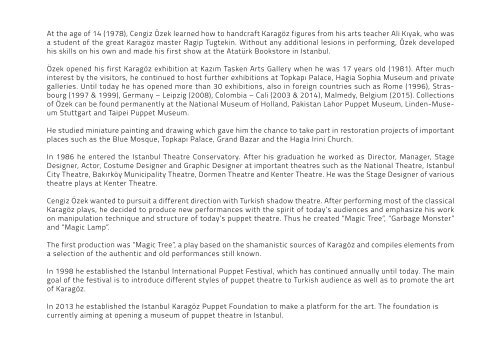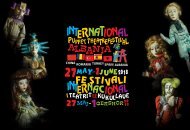You also want an ePaper? Increase the reach of your titles
YUMPU automatically turns print PDFs into web optimized ePapers that Google loves.
At the age of 14 (1978), Cengiz Özek learned how to handcraft Karagöz figures from his arts teacher Ali Kıyak, who was<br />
a student of the great Karagöz master Ragip Tugtekin. Without any additional lesions in performing, Özek developed<br />
his skills on his own and made his first show at the Atatürk Bookstore in Istanbul.<br />
Özek opened his first Karagöz exhibition at Kazım Tasken Arts Gallery when he was 17 years old (1981). After much<br />
interest by the visitors, he continued to host further exhibitions at Topkapı Palace, Hagia Sophia Museum and private<br />
galleries. Until today he has opened more than 30 exhibitions, also in foreign countries such as Rome (1996), Strasbourg<br />
(1997 & 1999), Germany – Leipzig (2008), Colombia – Cali (2003 & 2014), Malmedy, Belgium (2015). Collections<br />
of Özek can be found permanently at the National Museum of Holland, Pakistan Lahor Puppet Museum, Linden-Museum<br />
Stuttgart and Taipei Puppet Museum.<br />
He studied miniature painting and drawing which gave him the chance to take part in restoration projects of important<br />
places such as the Blue Mosque, Topkapı Palace, Grand Bazar and the Hagia Irini Church.<br />
In 1986 he entered the Istanbul Theatre Conservatory. After his graduation he worked as Director, Manager, Stage<br />
Designer, Actor, Costume Designer and Graphic Designer at important theatres such as the National Theatre, Istanbul<br />
City Theatre, Bakırköy Municipality Theatre, Dormen Theatre and Kenter Theatre. He was the Stage Designer of various<br />
theatre plays at Kenter Theatre.<br />
Cengiz Özek wanted to pursuit a different direction with Turkish shadow theatre. After performing most of the classical<br />
Karagöz plays, he decided to produce new performances with the spirit of today’s audiences and emphasize his work<br />
on manipulation technique and structure of today’s puppet theatre. Thus he created “Magic Tree”, “Garbage Monster”<br />
and “Magic Lamp”.<br />
The first production was “Magic Tree”, a play based on the shamanistic sources of Karagöz and compiles elements from<br />
a selection of the authentic and old performances still known.<br />
In 1998 he established the Istanbul International Puppet Festival, which has continued annually until today. The main<br />
goal of the festival is to introduce different styles of puppet theatre to Turkish audience as well as to promote the art<br />
of Karagöz.<br />
In 2013 he established the Istanbul Karagöz Puppet Foundation to make a platform for the art. The foundation is<br />
currently aiming at opening a museum of puppet theatre in Istanbul.




